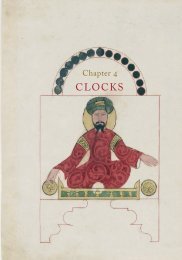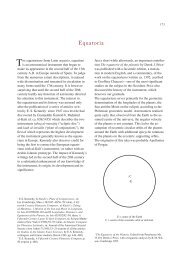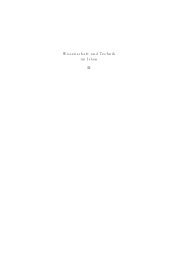Ch. 5: Clocks - Ibttm.org
Ch. 5: Clocks - Ibttm.org
Ch. 5: Clocks - Ibttm.org
Create successful ePaper yourself
Turn your PDF publications into a flip-book with our unique Google optimized e-Paper software.
c l o c k s 103<br />
clocks
104<br />
Dividers for the determination of prayertimes.<br />
Made after the description in an as yet<br />
unpublished manuscript, authored probably<br />
by Abū ‘Abdallāh MuΩammad b. Mūsā<br />
al-øwārizmī (1st half of the 9th c.).<br />
(cat. III, 85; B 2.08)<br />
sundial<br />
combined with a floating compass; model<br />
after a description and drawing by Abū<br />
‘Abdallāh MuΩammad b. Ibrāhīm ar-Raqqām<br />
(d. 1315), active under the Nasrids in Granada.<br />
(cat. III, 114; B 2.13)<br />
c l o c k s<br />
sundial, known as the ‹locust’s leg›<br />
A simple pocket-sundial, as described by<br />
Abu l-ºasan al-Marrākušī (13th c.).<br />
our model was made according to a syrian<br />
specimen dating from 1159, now preserved in<br />
the Bibliothèque nationale, Paris.<br />
(cat. III, 90; B 2.06)<br />
sundial<br />
After an instrument dating from 1537 ascribed<br />
to Pedro Nunes.<br />
(cat. III, 115; B 2.15)
sundial<br />
Made after a description and<br />
drawing by the Egyptian<br />
mosque-astronomer (muwaqqit)<br />
Zainaddīn ‘AbdarraΩmān b.<br />
MuΩammad Ibn al-Muhallabī al-<br />
Mīqātī, in his book dating from<br />
1426. calibrated for the latitude<br />
of cairo (30°).<br />
(cat. III, 93; B 2.02)<br />
c l o c k s 105<br />
sundial from the Ibn fiūlūn<br />
Mosque in cairo (1296). The sundial,<br />
does not exist anymore. The<br />
model is constructed according the<br />
Napoleonic Description de l’Égypte<br />
from the year 1798.<br />
(B 2.16)<br />
spanish-Arabic sundial<br />
After a description and illustration<br />
in the Libros del saber de<br />
astronomía (1267-1268) by the<br />
castilian king Alfonso X, being<br />
a compilation of predominantly<br />
Arabic-Islamic sciences.<br />
(cat. III, 113; B 2.04)
106<br />
sundialonstructed by al-Malik al-Ašraf<br />
‘Umar b. Yūsuf (reigned 1295-1296), the third<br />
sultan of the Yemeni Rasulid dynasty, for<br />
the latitude of cairo; reconstructed after a<br />
drawing in his book Mu‘īn afl-flullāb ‘alā ‘amal<br />
al-a◊flurlāb.<br />
(cat. III, 87; B 2.03)<br />
c l o c k s<br />
sundial, made by the astronomer<br />
Ibn al-∞āflir (d. 1375 ce) for the<br />
Umayyad Mosque at Damascus. It<br />
represents the apex of the sundial’s<br />
development. The original is broken<br />
in three pieces and now kept in<br />
the National Museum of syria in<br />
Damascus.<br />
(cat. III, 91; B 2.01)
chandelier clock<br />
Replica of a device described by the wellknown<br />
astronomer ‘Alī Ibn Yūnis (d. 1009)<br />
who was active in Egypt; he called this device<br />
for time-measurement ˚uraiya.<br />
(cat. III, 86; B 3.03)<br />
spanish-Arabic candle clock<br />
After the description and illustration of the<br />
Libros del saber de astronomía (1267-1268)<br />
of the castilian king Alfonso X, which<br />
essentially represents a compilation of<br />
Arabic-Islamic sciences.<br />
(cat. III, 112; B 3.08)<br />
c l o c k s 107<br />
The Andalusian “candle clock with<br />
Twelve Doors” for night hours according to<br />
lisānaddīn Ibn al-øaflīb (d. 1374).<br />
(cat. III, 97; B 3.09)<br />
The «candle clock with the scribe»<br />
In his book al-©azarī (ca. 1200) describes a<br />
candle clock made by a certain Yūsuf<br />
al-Asflurlābī. (cat. III, 96; B 3.10)
108<br />
Model of the Water clock from Fez<br />
This is, as far as we know, the oldest extant water<br />
clock. It was constructed in 1362 and belongs<br />
to the room allocated to the astronomer of the<br />
Qarawīyīn Mosque in Fez who is in charge of<br />
the calculation of prayer times. The water inflow<br />
was calculated so exactly that it remained<br />
uniform every second through 24 hours. The<br />
sinking of the float in the basin causes a minute<br />
pointer on a dial to move every four minutes<br />
c l o c k s<br />
construction scheme of the water clock from Fez<br />
and this, on the other hand, causes the pulling<br />
of two carriages, one loaded with small balls,<br />
the other with big ones. By falling into ringing<br />
bowls, the big balls indicate the full hours,<br />
while the small ones indicate intervalls of four<br />
minutes. Moreover, at every full hour one of the<br />
doors behind the bowls opens.<br />
(cat. III, 106; B 1.04)
A Balance clepsydra indicating Minutes<br />
Al-øāzinī describes in his book written in<br />
1121 ce a kind of balance for “weighing”<br />
minutes. suspended on one side of the beam<br />
is a basin which leaks water in a calculated<br />
amount. Its decreasing weight thus becomes a<br />
measure of elapsing time that can be evaluated<br />
by counterbalancing a weight on the other<br />
side of the lever.<br />
(cat. III, 117; B 1.11)<br />
c l o c k s 109<br />
Model of al-©azarī’s Goblet clepsydra<br />
(ca. 1200 ce). The sophisticated water-powered<br />
mechanism is hidden inside.<br />
(cat. III, 103; B 1.10)
110<br />
spanish-Arabic Water clock<br />
After a description and illustration in the<br />
Libros del saber de astronomía (1267-1268)<br />
by the castilian king Alfonso X, being a<br />
compilation of predominantly Arabic-Islamic<br />
sciences.<br />
(cat. III, 109; B 1.03)<br />
c l o c k s<br />
Mercury clock<br />
After a description and illustration in the<br />
Libros del saber de astronomía (1267-1268)<br />
by the castilian king Alfonso X, being a<br />
compilation of predominantly Arabic-Islamic<br />
sciences.<br />
(cat. III, 110; B 3.04)<br />
Water clock with the alarm function described<br />
in a latin manuscript from the 13th<br />
century. The mechanism of the clock betrays<br />
similarity with the water clock described in<br />
al-©azarī’s book.<br />
(cat. III, 116; B 1.05)
Mechanical Weight driven clock made<br />
by the ottoman scholar Taqīyaddīn,<br />
reconstructed according to the description<br />
and illustrations in his book on clocks.<br />
(cat. III, 119; B 3.12)<br />
c l o c k s 111<br />
Mechanical clock with spring Tension and<br />
striking Mechanism made by the ottoman<br />
scholar Taqīyaddīn, reconstructed according<br />
to the description and illustrations in his<br />
book on clocks.<br />
(cat. III, 119; B 3.14)
112<br />
c l o c k s










